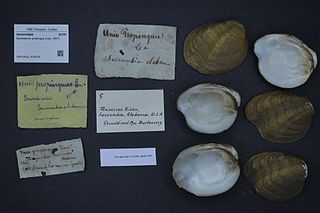Alasmidonta atropurpurea, common name Cumberland elktoe, is a species of freshwater mussel, an aquatic bivalve mollusk in the family Unionidae, the river mussels.

Epioblasma arcaeformis, the sugarspoon or arc-form pearly mussel, was a species of freshwater mussel, an aquatic bivalve mollusk in the family Unionidae, the river mussels. No live individuals have been observed since the early 20th century and it is presumed to be extinct.

Epioblasma is a genus of freshwater mussels, aquatic bivalve mollusks in the family Unionidae, the river mussels. Most of the species in this genus have been lost in modern times, and the entire genus is threatened with the possibility of extinction.

The oyster mussel is a rare species of freshwater mussel in the family Unionidae. This aquatic bivalve mollusk is native to the Cumberland and Tennessee River systems of Kentucky, Tennessee, Alabama, and Virginia in the United States. It has been extirpated from the states of Georgia and North Carolina. It is a federally listed endangered species of the United States.

Epioblasma flexuosa, the arcuate pearly mussel or leafshell, was a species of freshwater mussel, an aquatic bivalve mollusk in the family Unionidae, the river mussels. This species was endemic to the United States, where it was found in the major drainages of the Ohio River, including the Cumberland, Tennessee, and Wabash Rivers. Its natural habitat was flowing water.

Epioblasma haysiana, the acornshell or acorn pearly mussel, was a species of freshwater mussel, an aquatic bivalve mollusk in the family Unionidae. It is now extinct.
Epioblasma lenior, the narrow catspaw or Stone's pearly mussel, was a species of freshwater mussel, an aquatic bivalve mollusk in the family Unionidae, the river mussels.
The forkshell or Lewis pearly mussel, scientific name Epioblasma lewisii, was a species of freshwater mussel, an aquatic bivalve mollusk in the family Unionidae, the river mussels.
The upland combshell was a species of freshwater mussel in the family Unionidae. It was endemic to the upper Mobile River Basin in the southeastern United States.
Epioblasma othcaloogensis, the southern acornshell or southern acorn riffle shell, was a species of freshwater mussel in the family Unionidae. It was only known from the Coosa and Cahaba Rivers of the southeastern United States.
Epioblasma penita, the southern combshell or penitent mussel, is a species of freshwater mussel, an aquatic bivalve mollusk in the family Unionidae, the river mussels.
Epioblasma personata, the round combshell or fine-rayed pearly mussel, is an extinct species of freshwater mussel in the family Unionidae. It was endemic to the drainages of the Tennessee River and Ohio River in the United States.

Epioblasma propinqua, the Tennessee riffleshell or nearby pearly mussel, was a species of freshwater mussel in the family Unionidae. It was endemic to the United States, where it was found in the drainages of the Cumberland River, Ohio River, and Tennessee River.

Epioblasma sampsonii, the Wabash riffleshell or Sampson's naiad, was a species of freshwater mussel in the family Unionidae. It is now extinct.

Epioblasma stewardsonii, the Cumberland leafshell or Steward's pearly mussel, is an extinct species of freshwater mussel in the family Unionidae.

Epioblasma turgidula, the turgid blossom pearly mussel, turgid riffle shell, turgid-blossom naiad or turgid blossom, was a species of freshwater mussel, a mollusk in the family Unionidae. It is now extinct.
Pleurobema marshalli, the flat pigtoe or Marshall's mussel, was a species of freshwater mussel in the family Unionidae, the river mussels. It was native to Alabama and Mississippi, but it has not been seen since 1980. Though it is still listed as critically endangered on the IUCN Red List and as an endangered species on the US Endangered Species List, it is likely extinct.

Epioblasma torulosa, commonly called the tubercled blossom, is a species of freshwater mussel, a mollusk in the family Unionidae. It is native to eastern North America, where it is considered endangered in both Canada and the United States.

Theliderma tuberosa, the rough rockshell, is a species of freshwater mussel. It is an aquatic bivalve mollusk in the family Unionidae, the river mussels. It has sometimes been treated as a variety or big-river ecotype of Theliderma metanevra, due to only having slight shell differences.












